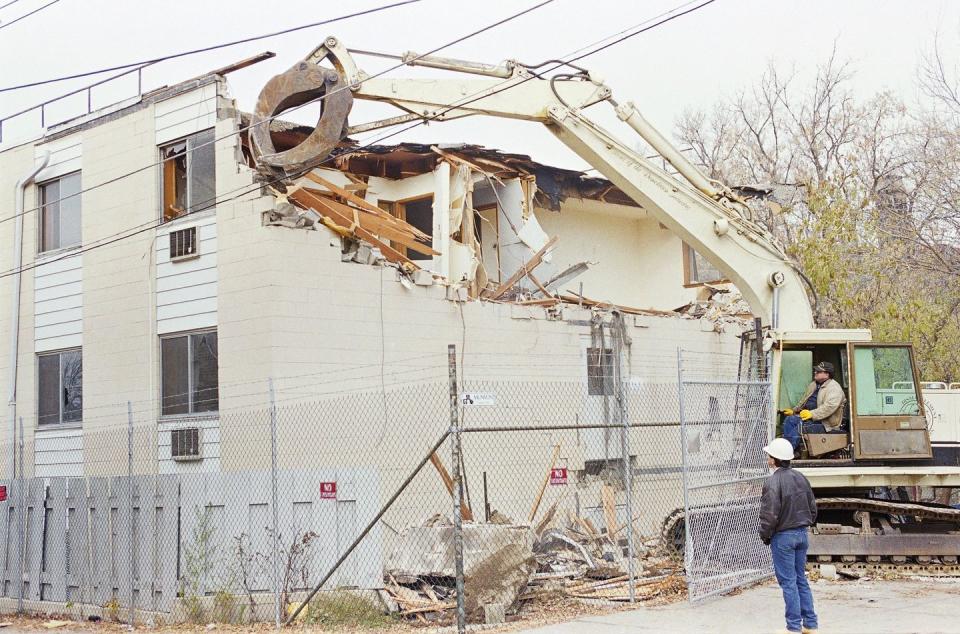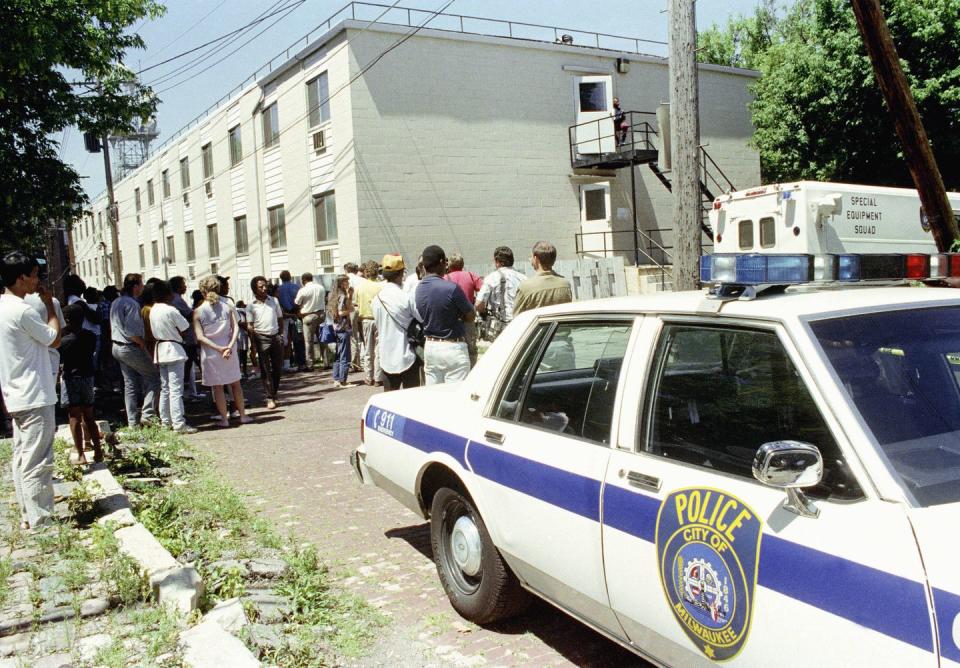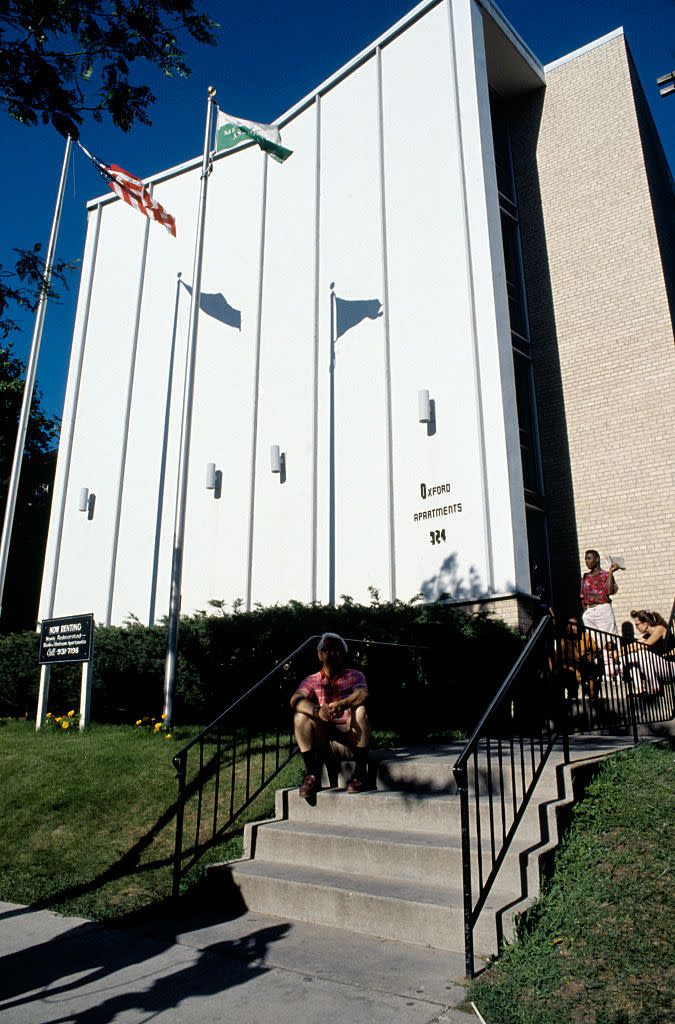Here's What The Police Found In Jeffrey Dahmer's Apartment

"Hearst Magazines and Yahoo may earn commission or revenue on some items through the links below."
Jeffrey Dahmer is getting a lot of attention right now after the release of Netflix's limited hit series, Monster: The Jeffrey Dahmer Story. The miniseries chronicles the serial killer’s gruesome and tragic murders while providing bone-chilling reenactments of his crimes—many of which took place in his very own apartment. Now, Netflix has dropped another Dahmer-related show, Conversations with a Killer: The Jeffrey Dahmer Tapes, which reveals never-before heard tapes from his defense team.
In case you're new to this real-life horror story, Jeffrey Dahmer, who is played by actor Evan Peters, is an infamous serial killer, and his crimes involve murder, cannibalism, and necrophilia. Dahmer was eventually caught and convicted for his crimes in 1992 after a 13-year killing spree that included at least 17 murders.
Many of the killings took place in Jeffrey Dahmer's apartment, and true-crime junkies want to know if the spooky spot still exists. So, here are all the details on where the horrific crimes occurred, what actually happened there, and whether the apartment still exists today.
Where did Jeffrey Dahmer live?
Dahmer lived in the Oxford Apartments, in apartment 213, which was located at 924 North 25th Street in Milwaukee, Wisconsin, per FBI records. He also lived at his grandmother’s home for a while, which is listed at 2357 S 57th Street, Milwaukee, Wisconsin.
He lived at his grandma’s home for around nine years until she threw him out in 1990.
Dahmer committed murders in both of these locations, as well as at his childhood home.
What happened at 924 North 25th Street?
Dahmer targeted mostly gay men of color, whom he picked up at bus stops, bars, malls, and adult bookstores in the area. He would convince the men to come home with him by promising beer or money in exchange for posing naked for photos, The New York Times reported.
Dahmer would then drug his victims' drinks before killing them. He stored the remains of several victims in his refrigerator, and even ate some parts of their bodies, the newspaper reported at the time.
“I didn’t want them to leave,” Dahmer told the police by way of explanation after his arrest.
He killed twelve men at this location, per Newsweek.
What did police find at his apartment?
Dahmer’s apartment was filled with tools that led the authorities to conclude it was a “killing factory,” per The New York Times. Police found ether and chloroform, believed to be used to drug his victims, and a barrel of hydrochloric acid which he used to dissolve the men’s bodies and preserve their skeletons. Inside that 57-gallon barrel, police found three torsos dissolving.
All in, the police discovered body parts, gruesome souvenirs, bones, and corpses of 11 people in his apartment, per FBI records. They also found all kinds of knives and sawblades, a hypodermic needle, an electric drill, and photographs, records show.
The Netflix show's recreation of Dahmer's apartment is eerily spot-on.
FBI photos from the time of Dahmer's arrest reveal that Monster's sets were disturbingly accurate, per Esquire. Dahmer really did own a beige couch, vintage fish tank, a roll of carpet on the floor, a tiny analog television, and a barrel for acid. And there were blood stains in Jeffrey's room that were basically impossible to clean up.
He also dismembered victims at his grandmother’s house in Milwaukee.
When Dahmer was discharged from the army in 1981 due to alcohol abuse, he originally lived with his stepmother and his father (who are played by Molly Ringwald and Richard Jenkins in the series), per The Cinemaholic. Dahmer continued to drink heavily, and was eventually arrested for disorderly conduct, according to Distractify.
After that incident, Dahmer's dad sent him to live with his grandmother, Catherine Dahmer, in Wisconsin. Things continued to go downhill from there.
By 1987, Dahmer had started killing again. He killed his second victim, Steven Tuomi, in a hotel room, but brought the body back to his grandmother's home in a suitcase to dismember it, according to Biography.
He is believed to have killed another three people at his grandmother's home after Tuomi's death.
Dahmer's grandmother eventually asked him to move out of her home in 1988, but he wouldn't actually move out until 1990. At that time, the killings continued in Dahmer's North 25th Street apartment, according to Distractify.
Catherine Dahmer was not aware of her grandson's crimes at the time.
Dahmer took Polaroids of his victims and stashed the photos inside his dresser drawer.
In the Netflix series, there’s a lot of talk about the graphic Polaroid photos that Dahmer would take of his deceased victims in his apartment.
In fact, a 1994 study in The American Journal of Forensic Medicine and Pathology revealed that Dahmer often photographed his victims’ body parts and nude corpses “in sexually suggestive positions” because he "wanted to keep them as mementos to keep him company," per Distractify.
After one of his would-be victims, Tracy Edwards, escaped and led police back to his home, officers found Dahmer’s disturbing pictures—many of which showed the nude dead bodies during various stages of dismemberment—in the killer’s bedside table drawer, per Distractify.
Jeffrey Dahmer's original Polaroids of his victims and photographs of his apartment are online.
Some of the photos from the crime scene and the investigation can be found through the Milwaukee Journal Sentinel files here.
Is Jeffrey Dahmer's apartment still standing?
Dahmer's apartment was torn down in November 1992, 15 months after the human remains were discovered, at the request of the victim’s families, per Newsweek. So, technically, it no longer exists.
But you can see what the outside of the apartment building used to look like, thanks to an avid ghost tour and serial killer aficionado on YouTube who goes by the name Shakers Milwaukee, per Esquire.


The building was purchased by a "collaborative neighborhood redevelopment initiative"
called the Campus Circle Project in 1995, who planned to plant grass and flowers at the location, per The Tab.

The president of the project, Patrick LeSage, called Dahmer’s home a "symbol of anger, pain, violence, and death” when talking to The Bulletin in 1992. "It needs to be replaced with a sign of our commitment to support the healing process and to work together as a community of people who care,” he said, per Newsweek.
Can you visit the site?
Yes. Although it is now just an empty lot, you can still drive past it and look at the empty space where his apartment used to stand. But that sounds pretty freaky.
Monster: The Jeffrey Dahmer Story is streaming on Netflix now.
You Might Also Like

